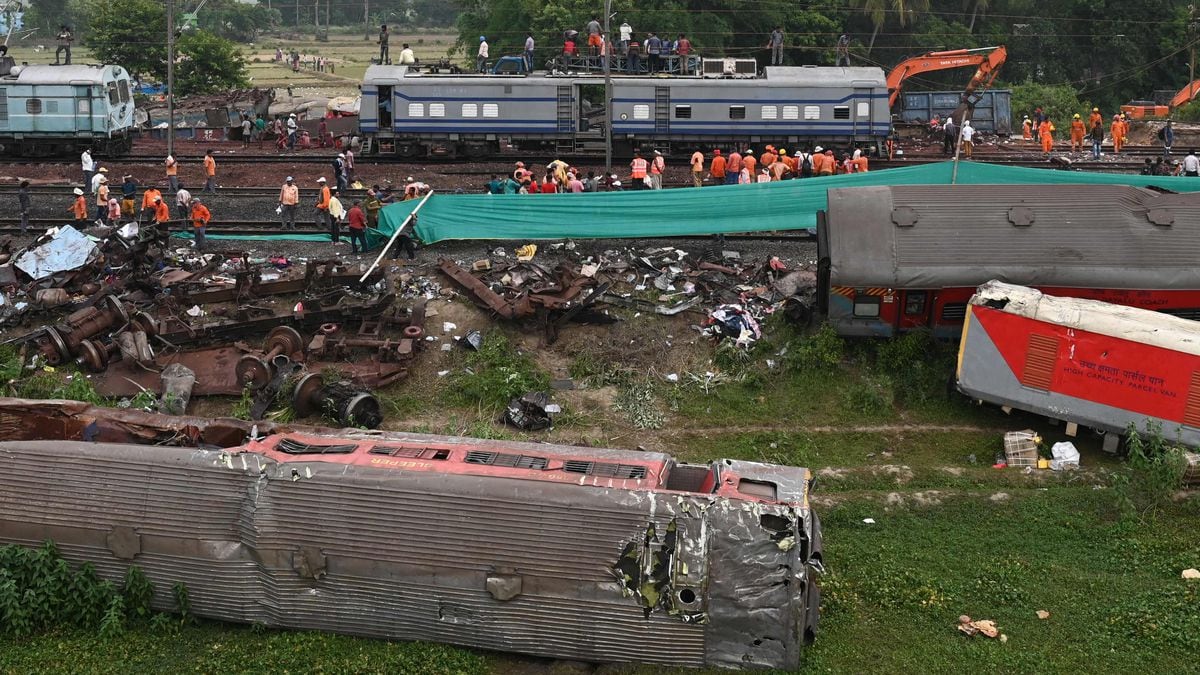On Sunday, Indian authorities ended efforts to rescue passengers of trains that derailed on Friday. The official number of deaths has dropped to 275, 13 fewer than those approved on Saturday. “Some of the dead bodies were double counted,” Pradeep Jena, general secretary of the eastern state of Odisha, where the accident took place on Sunday, explained. But the number of injured has risen to 1,200. At least 900 people have already been discharged from hospital, while 260 of them are still in hospital, one of them in serious condition, according to figures provided by the Odisha government. “Now the rescue is complete,” Gina told Reuters.
The investigation into the causes of the accident is now focused on how the Coromandel Express entered the service road, when it was already occupied by another vehicle. Managing route changes is done using a computer system, one of the Indian Railways executives, Jaya Varma Sinha, explained at a news conference compiled by Reuters, “It should not have allowed Coromandel to enter this track.” “We suspect something happened in the signaling system, a malfunction, but we are awaiting the safety committee’s conclusions,” he added.
Indian Railways has defended its management: it ensures that one of its priorities is improving security and it stresses that it works with aging infrastructures. Although there is no official version of what happened so far, the initial conclusions of the investigations indicate that the Coromandel Express train, which left Kolkata in the direction of Chennai, deviated on Friday from the main road and ended up on a secondary road, where a freight train was stopped, It hit at 128 kilometers per hour around 7:00 pm local time (3:30 pm in mainland Spain).
The collision caused the head, as well as the first carriages – “four or five”, according to the General Railway Company – to derail and invade the adjacent track. The Howrah Superfast Express was spinning through it at 126 kilometers per hour. The last two convoys suffered a plane crash, which also affected the rest of the trains, and left the tracks. The latter fell upon those who had been scattered across the area shortly before, exacerbating the incident and creating chaos, with deaths, injuries and irons piling up and mixing.
The management team of the public company, under the Ministry of Railways, has also requested the involvement of the Central Bureau of Investigation (CBI) in the investigation, branch minister Ashwini Vaishnau confirmed. “The goal is to finish the cleaning work on Wednesday to restore life to normal and restart the roads,” the minister told Reuters, who also talked about finding the “criminals”, hinting, without evidence and without giving further details. potential sabotage.
Join EL PAÍS to follow all the news and read without limits.
Participate
Those found guilty will be severely punished.” Prime Minister Narendra Modi made the announcement on SaturdayWhen he visited the area to accompany the survivors and relatives of the deceased. The multiple collision in Odisha is one of the country’s worst railway tragedies in decades, and one year after a general election was called, it has reopened the debate over railway safety in the Asian country, whose network is nearly 68,000 km. , is the fourth largest in the world and currently “after several years with a decrease in the number of passengers as a result of the Covid pandemic” it is used by about 13 million passengers per day, as confirmed by the public company.
In recent years, Modi’s government has initiated a railway modernization plan — with an investment of about €28,000 million, according to Afp — that has included running “high-speed” trains (which can travel at a maximum speed of 130 kilometers per hour) to make it easier to connect the country and revitalize the economy. Modi was to introduce a new electric train on Saturday, between Mumbai and Goa, which, as announced, is equipped with a modern safety system to avoid collisions.
The Modi government’s railway modernization had already been criticized by the opposition for not being accompanied by infrastructure renovation or improved security conditions. The train is the preferred – and most economical – mode of transportation in India, which has replaced China as the world’s most populous country. “Every day in India, an average of around 20,000 train journeys are scheduled. Operational failures are not uncommon,” Subodh Jain, a former Indian Railways worker and director of the company between 2011 and 2013, told Afp. According to this expert, the pressure of managing many paths is so high that it becomes complicated. “A radical change is necessary,” he added.
Follow all international information on Facebook And Twitteror in Weekly newsletter.

“Unapologetic tv specialist. Hardcore zombie trailblazer. Infuriatingly humble problem solver.”


:quality(85)/cloudfront-us-east-1.images.arcpublishing.com/infobae/BGXG27SUTRALDNB2EHXZ4YA4KQ.jpg)
:quality(85)/cloudfront-us-east-1.images.arcpublishing.com/infobae/BFYV24BM3NAJHPEGQ5M4DJSX5M.jpg)



More Stories
This Sunday, the Dominicans will elect a president from among nine candidates ›World› Granma
Who is the alleged attacker of Slovak Prime Minister Robert Fico?
Tomorrow, the Dominicans will elect a president from among nine candidates